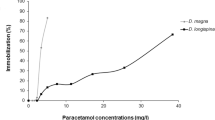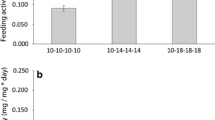Abstract
This study describes the toxicity of deltamethrin, in relation to its LD50 value, as well as variation in respiratory metabolism of the isopod species Porcellio scaber Latr kept at 3 temperature values (10, 22 and 30ºC). The low LD50 values obtained indicate that deltamethrin is a highly toxic pyrethroid for the crustacean tested, particularly at 10ºC. We also observed that, in all the 3 experimental temperatures, the deltamethrin toxicity was lower in females than in males. Particularly distinct differences between both sexes were visible at 10 and 30ºC, i.e. temperatures that are too low and too high for the species studied. Oxygen uptake measurement showed an increase in respiratory metabolism directly after intoxication. The most substantial increase, 64 % in males and 80 % in females, was observed at the temperature 10ºC, whereas at the other temperatures, it did not exceed 20 %. During the successive experimental days, the respiratory consumption in P. scaber had a tendency to decrease, which was more visible at 10 and 30ºC, compared to the optimal temperature 22ºC.


Similar content being viewed by others
References
Bennet D, Crossland NO, Shires SW (1980) Spray drift from Ripcord applications to vineyards in France: fate and effects in adjacent streams. Sittingbourne, Shell Research (TLGR. 80.095)
Beskid M, Kłos M, Suwała Z, Szyszkowska A, Wójcik J (1973) Wpływ malationu na niektóre odczyny enzymów oddechowych i ultrastrukturę mitochondriów wątroby szczura. Rocznik PZH 24:741–748
Cortet J, Gomot-De Vauflery A, Poinsot-Balaguer N, Gomot L, Texier C, Luzeau D (1999) The use of invertebrate soil fauna in monitoring pollutant effects. Eur J Soil Biol 35(3):115–134
Delabie J, Bos C, Fonca C, Masson C (1985) Toxicity and repellent effect of cypermethrin on Choney Bee: laboratory, glasshouse and shell experiment. Pectic SCJ 16:409–415
Eijsackers H (1991) Litter fragmentation by isopods as affected by herbicide application. Neth J Zool 4:245–303
Gromysz-Kałkowska K, Oder M (1983) Humidity, light and thermal preferendum of some terrestrial Isopods. Folia Biol (Kraków) 31:279–295
Gromysz-Kałkowska K, Szubartowska E (1984) Oxygen consumption in two terrestrial species of crustaceans (Isopoda). Bull Pol Acad Sci Biol Sci 32:47–56
Gromysz-Kałkowska K, Szubartowska E (1994) Respiratory metabolism of millipedes after poisoning with cypermethrin. Bull Environ Contam Toxicol 53:765–770
Gromysz-Kałkowska K, Szubartowska E, Bieńko M (1994) Rola krocionogów w przyrodzie i gospodarce człowieka. Przegląd Zoologiczny XXXVIII 1–2:25–34
Gromysz-Kałkowska K, Szubartowska E, Białkowska I, Bieńko M (1995) Toksyczność wybranych pestycydów dla Ortomorpha gracilis C.L.Koch Kieleckie. Stud Biol 8:43–50
Gromysz-Kałkowska K, Unkiewicz-Winiarczyk A, Szubartowska E (2000) The influence of environmental contamination on respiratory metabolism and humoral immunity in Cylindroiulus burzenlandicus Verh. (Diplopoda, Julidae). Fragm Faun 43:207–221
Keister M, Buck J (1964) Respiration: Some exogenous and endogenous effects on rate of respiration. In: Rockstein M (ed) Physiology of insecta, vol 3. Academic Press, New York, pp 617–658
Klekowski R (1975) Constant-pressure volumetric microrespirometer for terrestrial invertebrates. In: Grodziński W, Klekowski R, Duncan A (eds) Methods for ecological bioenergetics. Blackwell Scientific Publications, Oxford, pp 212–225
Litchfield JT, Wilcoxon F (1949) A simplified method of evaluating dose-effect experiments. J Pharm Exp Ther 96:99
Malinowski M (1986) Wpływ temperatury na aktywność owadobójczą fotostabilnych piretroidów. Roczn Nauk Roln ser. E 12:245–255
Migula P (1991) Strategie adaptacji bezkręgowców do środowisk zanieczyszczonych metalami. Biotechnologia 3–4:13–14
Nowosichow KW, Żukowski SG, Smirnowa JM (1975) Penetration and translocation of organophosphorus insecticides in insects. A-Union Plant Protection Institute USSR III:718–721
Paoletti MG, Hassall M (1999) Woodlice (Isopoda: Oniscoidea): their potential for assessing sustainability and use as bioindicators. Agric Ecosyst Environ 74:157–165
Różański L (2002) Przemiany pestycydów w organizmach żywych i środowisku. Agra-Enviro Lab, Poznań
Rusiecki W (1973) Toksykologia srodków ochrony roślin. PZWL, Warszawa
Sitkiewicz D, Konecka A (1975) Wpływ insektycydów fosforoorganicznych na utlenianie bursztynu i aktywność oksydazy cytochromowej wątroby szczura. Rocznik PZH 3:357–364
Skworcow AA (1946) Pronicajemnost’ pokrowow nasiekomych w otnoszenii kontaktnych insekticidow. Uspiechi sowriem. Bioł 21
Unkiewicz A, Gromysz-Kałkowska K, Szubartowska E (1998) Respiratory metabolism and immune response of Diplopoda and Isopoda in cadmium pollution. Procedings of 2nd iternational conference “Trace elements effects on organisms and environment”, Cieszyn, Poland p 205–213
Unkiewicz-Winiarczyk A (1999) Wpływ skażenia środowiska na metabolizm oddechowy i reakcje obronne u niektórych makrosaprofagów. Praca doktorska UMCS p 1–119
Unkiewicz-Winiarczyk A, Gromysz-Kałkowska K, Szubartowska E (2003) Effect of litter acidity on mortality and oxygen consumption of some Isopoda and Diplopoda. Acta Biol Cracov Series Zool 45:65–71
Walker CH (2002) Podstawy ekotoksykologii. Wydawnictwo Naukowe PWN, Warszawa
Wigglesworth VB (1942) Some notes on the integument of insects in relation to entry of contact insecticides. Bull Ent Res 33:205–218
Witkowski W (1984) Trzecia generacja pestycydów. Przemysł Chemiczny 63(8):436–437
Zitko V, Mcleese DW, Metcalfe CD, Carson WG (1979) Toxicity of permethrin, decamethrin and related pyrethroids to salmon and lobster. Bull Environ Contam Toxicol 21:338–343
Author information
Authors and Affiliations
Corresponding author
Rights and permissions
About this article
Cite this article
Unkiewicz-Winiarczyk, A., Gromysz-Kałkowska, K. Effect of Temperature on Toxicity of Deltamethrin and Oxygen Consumption by Porcellio scaber Latr (Isopoda). Bull Environ Contam Toxicol 89, 960–965 (2012). https://doi.org/10.1007/s00128-012-0814-5
Received:
Accepted:
Published:
Issue Date:
DOI: https://doi.org/10.1007/s00128-012-0814-5




